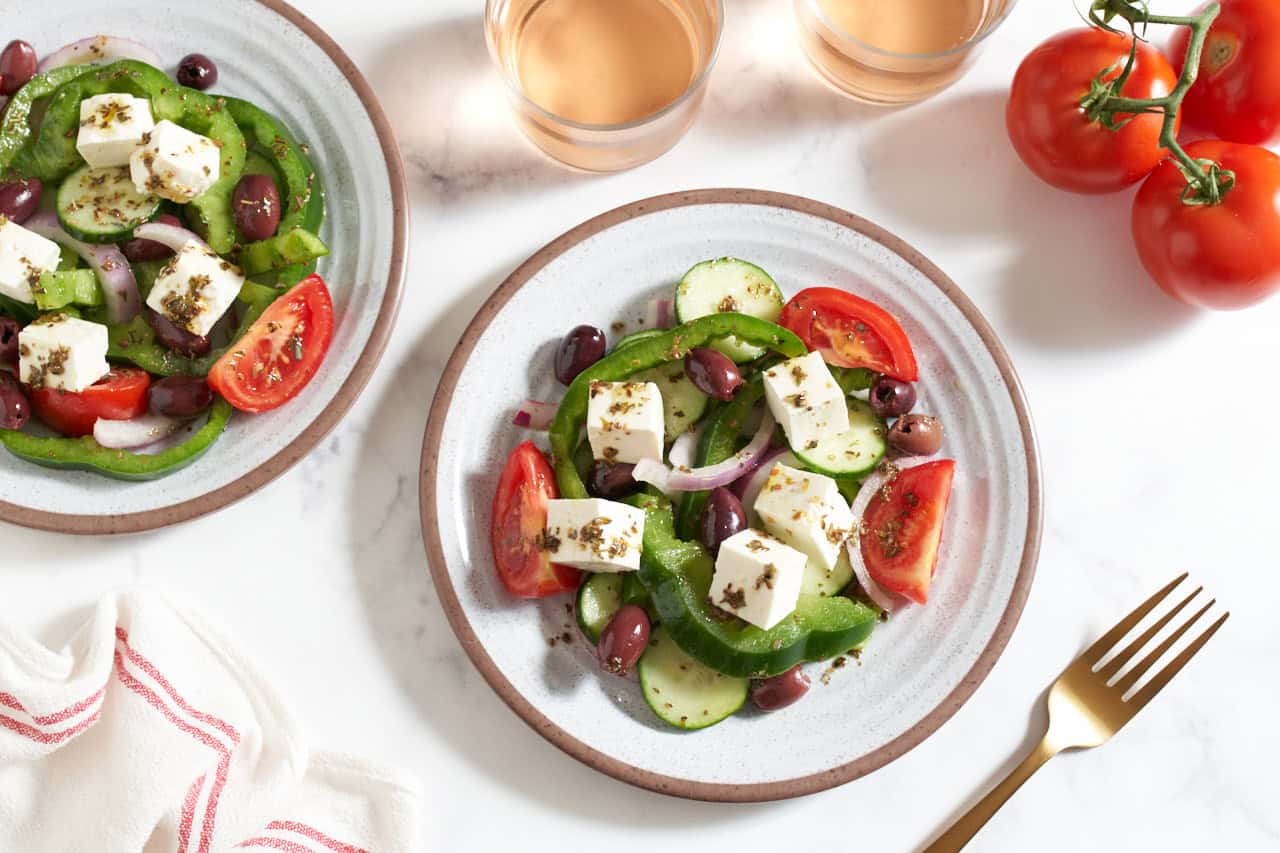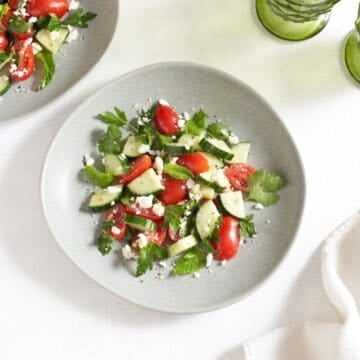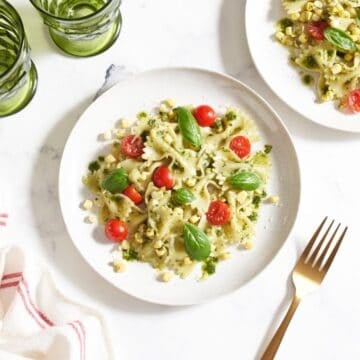This easy traditional Greek salad without lettuce has classic ingredients like real feta cheese and kalamata olives for the best Mediterranean flavor! It's cool and crisp, and you can make it in 10 minutes!

When I was traveling in Greece, the first time they sat a Greek salad down in front of me, this American girl was a bit surprised. Then I realized I was staring at a big block of feta cheese swimming in luscious olive oil and determined that I was actually in heaven.
Just like a garbanzo bean salad or a panzanella salad, a traditional Greek salad is made without lettuce, it's simply big chunks of vegetables and cheese. Eating one is a sensory experience, cutting and chopping and pairing the ingredients in different combinations on your fork.
Jump to:

Traditional Greek salad ingredients
- Feta cheese: The traditional way to serve Greek salads is with a large block of feta cheese in the center on top of all the other ingredients. It's really the star of the show. Use a block of real Greek feta cheese, not crumbled feta, but you can cut it up into smaller cubes to make things easier to serve if you like, as I did here.
- Cucumbers: I like to use English cucumbers because their skin is thinner and you don't have to peel them at all. Regular garden cucumbers or Persian cucumbers also work just fine.
- Kalamata olives: If you order a Greek salad in Greece, you'll get olives with the pits in them. I don't mind the pits but you can also buy pitted Kalamata olives.
- Tomatoes: Any kind of ripe summer tomato will work here, try tomatoes on the vine, cherry tomatoes, or heirloom tomatoes.
- Green bell pepper: Green bell peppers are the most traditional one to serve in a Greek salad, but if you want to sweeten things up, you can add or substitute red and yellow peppers. I definitely had some in Greece that had red pepper in them.
- Red onion: Don't fear the red onion, I'll teach you a trick to mellow the sharpness.
- Extra virgin olive oil, red wine vinegar, Greek oregano, kosher salt and freshly ground black pepper: Yes, please use Greek oregano to give the salad dressing the best flavor possible. It's so good and it does have its own unique taste! Don't overdo the salt in the dressing, the feta cheese will take care of most of the saltiness.
*Ingredients with measurements are listed in the recipe card below.
How to make a Greek salad without lettuce

Step 1: Slice the onion and soak in water
Slice the onion thinly and soak in a bowl of cold water. See expert tips below.

Step 2: Make the traditional Greek salad dressing
In a large mixing bowl, combine the olive oil, red wine vinegar, Greek oregano and salt. Whisk together and set aside.
Flavor-enhancing idea
Let the dressing sit for a few minutes to allow the dried oregano to bloom in the olive oil, so it will soften, and its flavor will permeate the dressing.

Want to save this recipe?
You'll join hundreds of readers on my email list!
Step 3: Chop the vegetables
Use a good chef's knife and slice the cucumber into ⅛-inch rounds, slice the tomatoes into wedges (or in half if using cherry tomatoes), and cut the green pepper into wide strips or rings.

Step 4: Assemble the salad
Drain the onions. Add the cucumber, onion, and green pepper to the bowl with the Greek salad dressing and toss to coat. Transfer to a serving plate. Reserve the remaining dressing in the bowl.
Arrange the tomatoes and olives on the plate with the other vegetables, then top with a block of feta or cubes of feta if you prefer. Drizzle the salad with the remaining Greek dressing, top with freshly ground black pepper and serve!

Expert tips
- Soak those onions: This is one of the best secrets I learned from working in restaurants for 20 years. Soaking the onion in water allows the flavor to mellow while you prep the rest of the ingredients.
- Leave the vegetables chunky: The fun part about a traditional Greek salad is that because there is no lettuce, the rest of the ingredients are in big chunks! It's an interactive experience breaking up the feta, deciding if you'll slice off some green pepper to go with some tomato or grabbing a crisp cucumber to pair with the briny bite of a Kalamata olive!
- Don't toss the tomatoes in dressing: The tomatoes are too delicate to get tossed in the dressing with the other vegetables, and they'd get their seeds and juice all over everything. Just add them to the serving plate, then drizzle dressing on top.
- Serve on a cold plate or in cold bowls: A Greek salad should be crisp and crunchy! Serving it in a cold bowl keeps all the veggies cold so they maintain their crisp texture. And it's so refreshing!
More Greek recipes
- Greek Stuffed Peppers were one of my go to dinners when traveling in Greece. Stuff them with any ground meat or make them vegetarian!
- Sheet Pan Greek Chicken and Potatoes has the side dish built right in!
Debra's Details: This Greek salad without lettuce is crisp, refreshing, and satisfying!
- No lettuce, just let the other vegetables shine!
- Real feta cheese = real Greek flavor.
- So cold and crisp, perfect for summer!
- Leave the veggies big and chunky for an interactive experience.
- Serve as a light vegetarian main course or a starter for any meal.
If you enjoy this recipe, please leave me a 5-star rating ⭐️⭐️⭐️⭐️⭐️ in the recipe card! It really helps others find my content and helps my business grow! Sign up for my newsletter for recipes delivered to your inbox and follow me on Instagram and Pinterest! Thank you!
Recipe

Traditional Greek Salad Recipe
Ingredients
Traditional Greek salad dressing
- ¼ cup extra virgin olive oil
- 2 tablespoon red wine vinegar
- 1 tablespoon Greek oregano
- ¼ teaspoon kosher salt
Greek salad
- 1 red onion
- 1 English cucumber
- 2 green bell peppers
- 2 large ripe tomatoes
- 1 cup Kalamata olives
- 8 ounces feta cheese in a block
Instructions
- Slice the red onion thinly, transfer to a bowl of cold water to soak while you prepare the rest of the ingredients. See note.
- In a large mixing bowl, combine the olive oil, red wine vinegar, Greek oregano and salt. Whisk together and set aside.
- Slice the cucumber into ⅛-inch rounds, slice the tomatoes into wedges (or in half if using cherry tomatoes), and cut the green pepper into wide strips or rings.
- Drain the onions. Add the cucumber, onion, and green pepper to the bowl with the Greek salad dressing and toss to coat. Transfer the vegetables to a serving plate. Reserve the remaining dressing in the bowl.
- Add the tomatoes and olives to the plate with the other vegetables, then top with a block of feta or cubes of feta if you prefer.
- Drizzle the salad with the remaining Greek dressing, top with freshly ground black pepper and serve!
Want to save this recipe?
You'll join hundreds of readers on my email list!
Notes
- Soak those onions: This is one of the best secrets I learned from working in restaurants for 20 years. Soak the onion in water while prepping the rest of the ingredients and the sharp flavor will mellow.
- Leave the vegetables chunky: The fun part about a traditional Greek salad is that everything is in big chunks! It's an interactive experience breaking up the feta, deciding if you'll slice off some green pepper to go with some tomato or grabbing a crisp cucumber to pair with the briny bite of a kalamata olive!
- Don't toss the tomatoes in dressing: The tomatoes are too delicate to get tossed in the dressing with the other vegetables, and they'd get their seeds and juice all over everything. Just add them to the serving plate, then drizzle dressing on top.
- Serve on a cold plate or in cold bowls: A Greek salad should be crisp and crunchy! Serving it in a cold bowl keeps all the veggies cold so they maintain their crisp texuture. And it's so refreshing!
- Try some ingredient variations: This recipe is what you'll commonly find throughout Greece, but ingredients can vary by region. Add capers, swap tomatoes for watermelon, or top with fresh parsley.
Nutrition
Nutrition information is automatically calculated as an estimate. Calorie accuracy is not guaranteed.






Leave a Reply